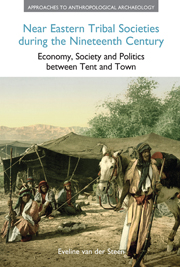 Near Eastern Tribal Societies during the Nineteenth Century
Near Eastern Tribal Societies during the Nineteenth Century Book contents
- Frontmatter
- Dedication
- Contents
- Acknowledgements
- Introduction
- 1 What is a tribe?
- 2 Travellers in the Levant during the nineteenth century
- 3 The dynamics of territorial and power structures
- 4 Oral traditions
- 5 Tribal society and its relation to the landscape
- 6 Tribal institutions
- 7 Relations between the tribes and the state
- 8 From tribe to tribal state: three case studies
- 9 The economy of tribal societies
- 10 Ethnicity and the sense of belonging
- 11 Women in tribal societies
- 12 Religion and folklore
- 13 Back in time: historical parallels
- Notes
- References
- Index
3 - The dynamics of territorial and power structures
- Frontmatter
- Dedication
- Contents
- Acknowledgements
- Introduction
- 1 What is a tribe?
- 2 Travellers in the Levant during the nineteenth century
- 3 The dynamics of territorial and power structures
- 4 Oral traditions
- 5 Tribal society and its relation to the landscape
- 6 Tribal institutions
- 7 Relations between the tribes and the state
- 8 From tribe to tribal state: three case studies
- 9 The economy of tribal societies
- 10 Ethnicity and the sense of belonging
- 11 Women in tribal societies
- 12 Religion and folklore
- 13 Back in time: historical parallels
- Notes
- References
- Index
Summary
There is a tide in the affairs of men.
Which, taken at the flood, leads on to fortune;
Omitted, all the voyage of their life
Is bound in shallows and in miseries.
On such a full sea are we now afloat,
And we must take the current when it serves,
Or lose our ventures.
(Shakespeare, Julius Caesar, Act 4)Introduction
The oldest written sources containing information about territorial interaction and politics involving local groups date from the Middle Bronze Age. The Egyptian execration texts provide us with lists of these groups, their leaders and territories. The story of Sinuhe tells about wandering Bedouin in the desert, and about power skirmishes with the local tribes around Byblos. In Mesopotamia, records describe the battle between the “desert and the sown” – Amorite nomadic groups who invaded territories at the expense of the settled population and created tribal states. The sources tell us little about the social organization of these groups, but what they offer suggests that it was not very different from the organization of the tribes from later periods, known from Assyrian and Babylonian records, the biblical narrative, or Roman and Byzantine sources, such as Ammonius and pseudo-Nilus. Islamic historians, and occasionally early European pilgrims such as Arculf, give information about the organization of early Islamic tribes. There is much that we do not know, and our understanding of past societies is likely to be coloured by a more modern perspective. However, these sources show that there is continuity, not in the history of the region, which is chequered enough, but in the structures and forces that shaped it.
- Type
- Chapter
- Information
- Near Eastern Tribal Societies during the Nineteenth CenturyEconomy, Society and Politics between Tent and Town, pp. 38 - 55Publisher: Acumen PublishingPrint publication year: 2013


